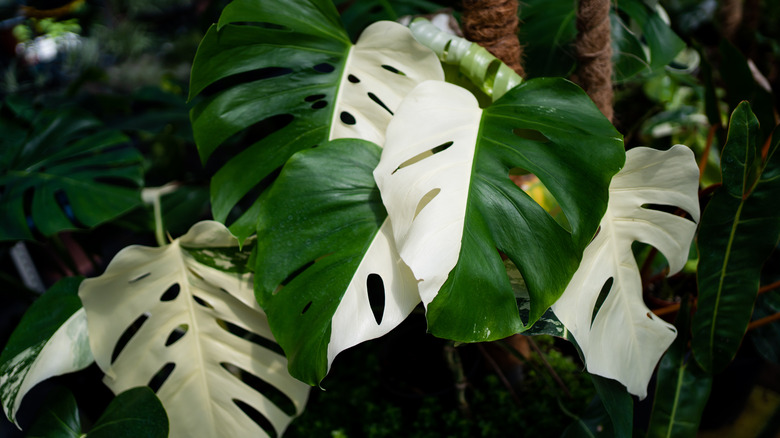What Does Variegated Mean For Houseplants, And How Can You Incorporate It Into Decor?
If you know someone with a green thumb (or twelve), you've probably heard them gush over a variegated plant in their home or emphasize how badly they want to buy one from their wishlist. You might have been too scared to ask your enthusiastic friend, but you probably wondered what on earth they were talking about. The term "variegated" originates from the Latin word "variagatus," which means "made up of many colors." Variegated plants have leaves with various shades of green, yellow, orange, or white. They can also display gorgeous patterns on their leaves, including speckles, dots, stripes, and blocks. Variegation is common in some plants and incredibly rare in others, so many houseplant enthusiasts love to grow and trade them like precious jewels.
Sure, they look nice, but what makes variegated plants so special and often expensive? Why will so many people go to the ends of the earth to obtain certain varieties, and which ones are best for beginners? Here's everything you've been dying to know about these rare and fascinating beauties and how you can help them thrive in your home.
What causes variegated plants?
To understand what causes plant variegation, you may need to think back to your school science classes. Plants use a pigment called chlorophyll to absorb sunlight and turn it into energy. Most plants in the world are a solid green color because chlorophyll is evenly distributed through their leaves, but some have genetic differences that affect chlorophyll production and distribution. In places without chlorophyll, other pigments may be visible, including carotenoids, which have an orange color, and xanthophylls, which have a yellow color. Where chlorophyll is absent, leaves may appear red or yellow, and where all pigments are absent, they may appear white.
There are several ways that variegation can happen in plants. For some, like croton petra, multicolored leaves are just part of their natural biology, but the most common cause for variegation is a genetic mutation that occurs as the plant grows. This common mutation is called chimera variegation, and there are three ways that it might present itself: sectorial, mericlinal, or periclinal. The monstera albo (pictured above) is a rare and dramatic example of sectorial chimera variegation, which creates whole segments of leaves without color. Mericlinal variegation often presents as streaks or dots, but the pattern may change or disappear as the plant grows and reproduces. Periclinal variegation often appears as pale or white edges on a green leaf, and the mutation will permanently remain in the plant and its offspring.
Keeping and styling variegated plants
Variegated plants are prized in the houseplant community because each individual is unique, and you can't easily force a plant to become variegated. Variegation isn't a disease, so these plants are perfectly healthy, but the coloring does have some effect on their care requirements. Just like very fair-skinned people, variegated plants are sensitive to sunlight. Believe it or not, plants can actually get sunburned, especially if they're underwatered. For this reason, it's best to keep your variegated plants indoors and in pots so you can move them around to avoid direct sunlight. Because they have less chlorophyll and, therefore, less energy, variegated plants tend to grow much more slowly than solid green indoor plants.
If you're ready to add a variegated plant to your collection, you're in for a treat. These fascinating houseplants add a whole new dimension to any space they're in. Some relatively affordable and low-maintenance options include variegated pothos like marble queen, snake plants, and rubber plants. For more experienced green thumbs, consider investing in a variegated monstera, alocasia, or even a striking monstera albo! Use variegated plants throughout your home to break up overly green areas and add some variety to your growing indoor jungle. To let their natural beauty shine, plant your new variegated friend in a solid or neutral-colored container that emphasizes its unique leaf pattern.


